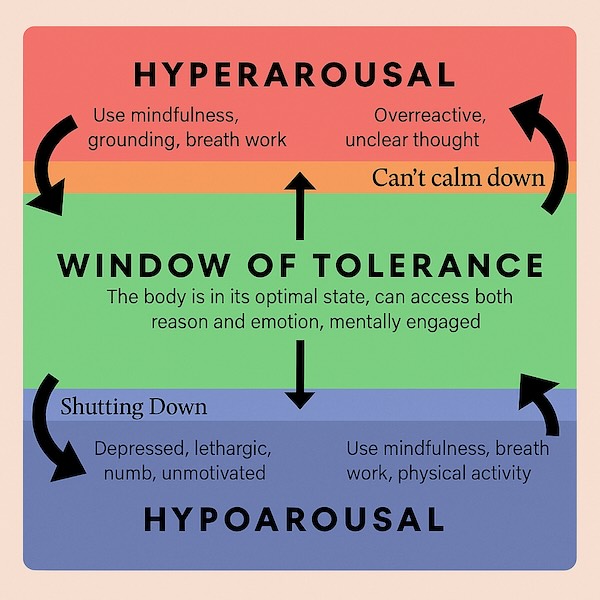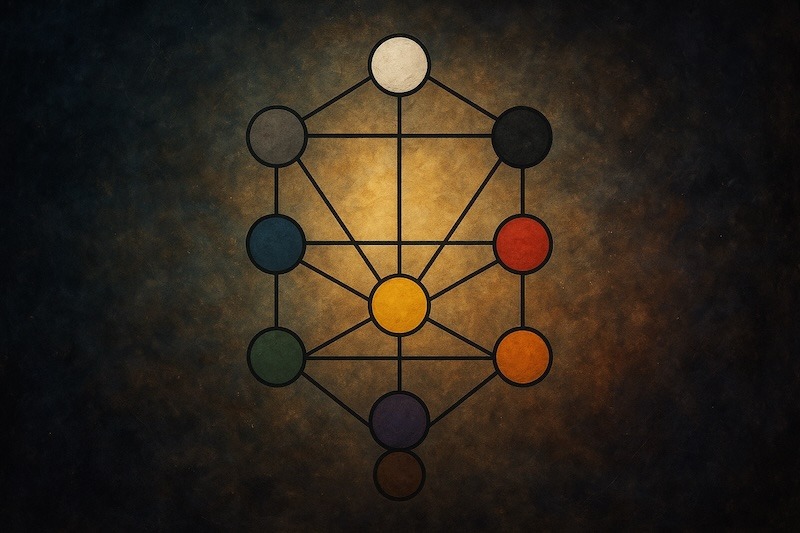“Healing happens when someone feels accompanied in a way they have never been accompanied before.”
In every therapeutic encounter—and especially in psychedelic-assisted work—the true foundation of safety and transformation is not the method, the medicine, or even the insight. It is the state of the nervous system. Regulation is the capacity to feel without being overwhelmed, to stay present without collapsing, and to return to yourself after intensity. It is what allows consciousness to open without being shattered.
This article explores regulation, co-regulation, dysregulation, and attunement through the lens of your workshop teachings, together with insights from A General Theory of Love, The Body Keeps the Score, somatic psychology, and the transpersonal work that defines Transcendent Psychology.
What Is Regulation?
Regulation is the nervous system’s ability to move through emotional and physical activation and come back to balance. It does not mean staying calm at all times. It means being able to experience sensations, thoughts, and emotions without losing access to yourself.
When the system is regulated, the body feels grounded, the breath flows naturally, and the mind remains coherent enough to integrate what is happening. Regulation is what makes it possible to stay present during an emotional wave, to remain embodied during a vision, to explore a difficult memory, or to allow grief to rise without drowning in it.
Bessel van der Kolk describes regulation as the biological capacity to “stay with internal experience without being hijacked by it.” In practice, this means that the body trusts that what is emerging can be felt, and that it can find its way home afterward.
For this reason, regulation is the invisible core of every healing process.
Dysregulation and the Window of Tolerance
Dysregulation happens when experience becomes too intense, too fast, or too unfamiliar for the nervous system, and the system shifts outside its window of tolerance. In everyday life, this might look like anxiety, emotional overwhelm, shutdown, or dissociation. In psychedelic or deep inner work, these patterns become amplified. This is understood in psychology when you are unable to maintain the autonomic coherence the window of tolerance margins are crossed and the nervous system is unable to process reality
Dysregulation often takes two primary forms:
- Hyperactivation, where the system accelerates—heart racing, breath quickening, tears or panic emerging, or the urgent feeling of wanting to leave the space.
- Hypoactivation, where the system dims—body becoming heavy or numb, a fading sense of presence, foggy awareness, difficulty responding, or a sense of “not being here.”
Dysregulation is not a sign that someone is doing something wrong. It is a protective mechanism. It is the body’s way of saying, “This is too much for me right now—help me slow down or find safety.”
Seeing dysregulation as protection rather than failure is essential for both facilitators and students.
Dysregulation is when:
- Fear becomes panic and terror
- Anger becomes rage
- Frustration becomes overflowing irritability
- Joy becomes mania and uncontrollable laughter
- Stillness becomes numbness and paralysis
This is how the Window of Tolerance looks like. Coherence is in the green zone while its extremes express both ends of dysregulation: hyperarousal and hypoarousal.

Expanding the Window of Tolerance
The Window of Tolerance is not fixed, it can broaden itself to be more tolerant, resilient and be less reactive to potential triggers. Through therapy, integration and co-regulation exercises you can expand the margins between your thresholds and be less reactive to what before was.
In The Body Keeps the Score, van der Kolk explains that trauma heals when the body learns, through repeated experience, that the danger is over. Co-regulation is one of the most powerful ways this learning occurs. A facilitator’s presence becomes a corrective relational experience—one that reorganizes implicit memory, reorganizes threat responses, and offers the body a new template for safety.
Regulation in Plant Medicine Facilitation
Psychedelic entheogens intensify perception, emotion, memory, and symbolism. They open internal material that normally remains hidden behind layers of defense, what we call the unconscious. This makes the process potentially transformative—yet also potentially overwhelming in thoughts, emotions and bodily sensations.
When a person is regulated during a plant medicine journey, they can stay connected to their intentions, surf emotional waves, and allow symbolic or autobiographical material to unfold with meaning. When regulation breaks down, the person can feel lost, frightened, disconnected, or overwhelmed by sensations they cannot name.
This is why facilitators are not simply “guides of visions,” but guardians of the nervous system. Their ability to hold presence, track subtle changes, and offer co-regulation directly shapes how safely a participant can explore the depths of their psyche.
Recognizing Signs of Dysregulation
Facilitators need to notice the early shifts—before someone spirals into panic or collapse. Common signs I recognize have to do with the shift in breathing, the blank look in the eyes, the tremble in the hands, or the person suddenly withdrawing into themselves.
Here is a more detailed list of the most common signs include:
- Rapid or shallow breathing
- A sudden wave of crying, fear, or agitation
- Body freezing or becoming very still
- Disconnection, confusion, or glazed eyes
- Repetitive statements like “I want to leave”
- Loss of sensation or difficulty feeling the body
These signs are invitations—not to intervene with force, but to offer presence, gentleness, and attunement. In psychedelic work, recognizing dysregulation early can prevent unnecessary fear and open a pathway for profound therapeutic repair.
How Co-Regulation Works
Co-regulation is the process by which one regulated nervous system helps another find balance. According to A General Theory of Love, human beings are biologically wired for limbic resonance—the capacity of one brain to tune the emotional state of another. In therapeutic and entheogenic settings, this resonance becomes the main stabilizing force.
Co-regulation begins with the facilitator’s state. A grounded, stable facilitator communicates safety before saying a single word. The tone of their voice, the rhythm of their breathing, the softness of their gaze, and the clarity of their presence all tell the participant, “You are safe here.”
Attunement deepens this process. It is the ability to feel with someone without overwhelming them—matching their pace, reading their signals, adjusting your approach moment by moment. Attunement means noticing when a person needs silence instead of words, slower speech instead of encouragement, or gentle orientation instead of interpretation.
The “field”—the shared emotional and energetic space of the session—also plays a vital role. Music, lighting, smell, timing, and even the facilitator’s intention shape the field. When these elements are coherent, they help the participant’s system move naturally toward regulation, much as a tuning fork vibrates when placed beside another.
Practical Example of Co-Regulation
During my latest workshop in Italy, I had the opportunity to demonstrate co-regulation in real time when one of the participants entered a panic response. Nothing about my approach was dramatic or complex. What made the difference was presence—simple, human, and steady.
The first thing I did was help her orient to the room. I moved gently into her line of sight and said,
“Look at me… you are here. You are in a safe place.”
As soon as she made eye contact, I could feel her breath begin to shift. Orientation brings the mind back online; it reduces the impulse to escape.
I slowed down my voice intentionally—soft, rhythmic, predictable. Before she could regulate herself, I had to regulate myself. My breath became her anchor. My pace became the nervous system she could borrow while hers reorganized.
I asked her to feel her legs again, to place her hands on her thighs, to notice the ground beneath her. I invited her to touch her arms and chest, to remind her body that it was still here. Her attention slowly returned from the storm inside to the reality of the present moment.
Throughout the process, I offered gentle verbal containment:
“This is going to pass… I am here… you are not alone… breathe with me”
I always asked before coming closer or using touch, explaining each step so there were no surprises. Consent creates safety; safety creates coherence.
This is co-regulation.
Not a technique, not a performance—just attunement, presence, and the willingness to meet someone exactly where they are.
What This Means for Facilitators and Students
To support others, facilitators must first be able to regulate themselves. On my trainings, I emphasize the work on the facilitator’s personal process before going into more advanced facilitation and integration. Students need to learn how they themselves respond to fear, activation, shame, or overwhelm; otherwise, their nervous system may collide with a participant’s rather than stabilizing it.
Facilitators are not meant to “fix” people—they are meant to accompany them. Their task is to hold a coherent presence, maintain attunement, and intervene only in ways that support the participant’s natural self-regulation.
This requires humility, sensitivity, and continuous self-observation. It also requires a deep respect for the mystery of each person’s psyche.
Conclusion: The Heart of Transcendent Psychology
Regulation is not simply a clinical concept; it is a spiritual and relational principle. It is the foundation that allows consciousness to expand safely, that transforms emotional pain into meaning, and that helps people reconnect with themselves in a way they never could before.
Through my Transcendent Psychology workshops you can explore this topic in depth and learn techniques and strategies to tune with the field and go to a next-level facilitation in your group work and retreats.






